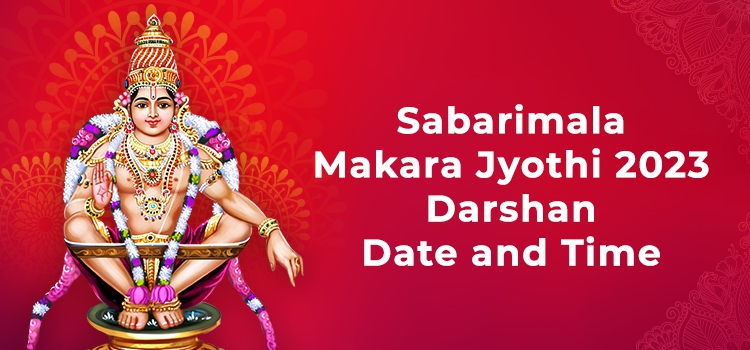Sabarimala Makara Jyothi 2023 Darshan Date and Time
Every year, in December, Kerala-bound trains and buses teem with pilgrims clad in black and carrying ‘irumudi kettus’ (cloth bundles containing offerings), chanting ‘Saranam Ayyappa’. It’s a sign that Sabarimala season has begun.
The pilgrims’ destination is the Sabarimala Ayyappa Temple, a hilltop shrine located within the densely wooded Periyar Tiger Reserve in the Pathanamthitta district. The deity who graces this shrine is Ayyappa or Sabarimala Sastha. Mythology claims that he was born to Shiva and Vishnu, who took the form of Mohini, an apsara. The child born of this union had a purpose to fulfill – end Mahishi’s reign of terror on earth.

Mythology behind Sabarimala
Mahishi was the sister of the demon, Mahisha, who was killed by Goddess Durga. She wanted to avenge her brother’s death and had obtained a boon whereby only a child born to Shiva and Vishnu could kill her. As both were male gods, she felt confident that they could never have a child together. Thus reassured of her invincibility, she unleashed havoc on earth.
The king of Pandalam, who was childless, came across the infant when hunting in the forest and raised him as his son, naming him Manikandan. When he grew to adulthood, the king wanted to make him his heir apparent even though the queen had delivered a son by then. The royal Dewan conspired with the queen to kill Manikandan so that her real son would become the crown prince.
Accordingly, the queen feigned a headache, and the royal physician announced that only a tigress’ milk would cure her. Manikandan volunteered to procure it. He set off to the forest, where he ran into Mahishi and killed her. Then he found a tigress and returned to the palace with it. By then, the king and queen realized that he was no ordinary boy. Though the king wanted to crown him his heir, Manikandan declined and returned to his heavenly abode.
However, the king built a temple for him at the spot where the shrine stands. Manikandan came to be called Sabarimala Sastha or Ayyappa Swamy. Every year, lakhs of Ayyappa devotees undergo a rigorous fast for a mandala (41 days) to visit the temple and pay their respects to the bachelor deity. Women of childbearing age are not allowed in the shrine.
Makara Jyothi
The temple is not open throughout the year. It opens only on the first day of each Malayalam month, as well as Vishnu and Mandala Pooja and the Makaravilakku festival. Mandala Pooja concludes with the sighting of the Makara Jyothi.
What is Makara Jyothi?
Makara Jyothi in Sabarmimala is the most important event at the temple. It is mostly on 14 January. First, the sacred jewels of Ayyappa (Thiruvabharanam) arrive at the temple in 3 boxes. When they arrive, lakhs of devotees present there chant 'Saranam Ayyappa' with great fervor.
The ornaments, which continue to be the private property of the Pandalam royal family, begin the journey from Pandalam to Sabarimala two days before Makara Jyothi as part of a procession. The person who carries the jewel boxes goes into a trance and begins to dance.
The Thiruvabharanam makes its way through Valiakoikkal Sastha temple at Pandalam, Ayiroor Puthia Kavu Temple, Perunattil temple, Vlakkai, Nilaikkal Siva temple, Vellachimala, Pamba, and Sabari Peedam before it reaches the Sannidhanam at 6.00 pm on Makara Jyothi day. An eagle or Garuda can be seen hovering and flying above the Thiruvabharanam boxes at this time.
When the boxes reach the Sannidhanam, the Melshanthi and Thanthri (chief priests) receive the jewels. The Thiruvabharanam comprises a diamond crown, necklaces, bracelets, and a sword. The deity is adorned with these, and Aarti is performed.
At the same moment, everyone assembled there witnesses a brilliant light on the northeastern side of the temple. It appears at the opposite mountain in Kantamala, a place that is supposedly the abode of devas and rishis. It is said that this brilliant flame of light or Makara Jyothi is the Aarti performed by the rishis and the devas. Another belief is that it is Ayyappa who appears as the light to bless his devotees. The sighting of the Makara Jyothi marks the culmination of the 2-month Sabarimala pilgrimage season that begins in mid-November.
According to the Travancore Devaswom Board, which manages the shrine, Makara Jyoti is a star (Sirius) and a natural phenomenon that appears on the horizon when 'Deeparadhana' is performed on Makara Sankranti day.
Significance of Makara Jyothi
Makara Jyothi marks the transition of the Sun from Sagittarius (Dhanus) to Capricorn (Makara).
The Sun begins its six-month journey in the northern direction on the celestial sphere. This is called ‘Uttarayana’. It concludes on 14 July, which is called ‘Karka Sankranti’. From July-January, the Sun travels among the southern constellations. This journey is ‘Dakshinayana’.
In the Hindu religion, ‘Uttarayana’ is one day, and ‘Dakshinayana’ is one night for the gods.
Sabarimala Makara Jyothi 2023 Time and Darshan
January 14, 2023, between 5.30 and 7.30 pm.



















